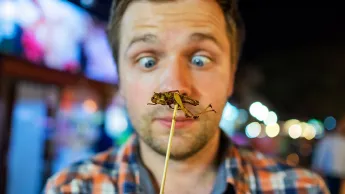Beetles and larvae: are insects a source of protein for the future?
- 2023-06-20
- Comments

People in many countries all around the world have been eating beetles, crickets and larvae for millennia. Today FAO, the Food and Agriculture Organization of the United Nations, considers insects to be a ‘food of the future’. Insects not only contain valuable protein, but many edible insects also contain omega-3 fatty acids, B vitamins and minerals. Above all, though, they are much more efficient than livestock at transforming plant foods into protein. Producing 100g of beef requires 2.4kg of animal fodder and 2,200L of water. Domestic crickets, by contrast, need only one twelfth of the food and one two-thousandth as much water to produce 100g of edible weight. The FAO believes that making greater use of insects as a food source could make a significant contribution to feeding the world’s growing population. According to the FAO, this would also help protect the climate, as mass livestock farming causes roughly 15% of global carbon emissions.
Feeding the world with insects: helping solve the hunger crisis
Mealworms, migratory locusts, domestic crickets and, most recently, lesser mealworms have been approved for human consumption in the EU since 2021. People who are allergic to crustaceans should not eat insects. Apart from this, no particular risks from consumption have been identified. Keeping and processing insects in Europe and Germany are subject to hygiene rules which are just as strict as those which apply to pigs, cows and poultry.
That said, if someone eats a fried locust here in Germany, they’re usually doing it to impress others rather than to have a filling meal. ‘There is still a long way to go before insects are considered normal food and not a challenge,’ says Anjani Nayak, an entomologist at Giessen University who studies the larvae of the black soldier fly (hermetia illucens). In future, consumers may be more receptive to consuming insects which have been dried and ground into powder and then processed into flower or pasta dough, rather than eating whole creepy-crawlies. More and more start-ups are producing products like these. However, they are still much more expensive than conventional foods.
Insects for fodder: a sustainable alternative to livestock farming
Nayak does not ultimately believe it is essential for everyone to switch over to eating insects. ‘Using insects for fodder is another excellent option,’ she says. Insects are rich in protein and fats, so they would make an environmentally-friendly alternative to soya and could also be used for fish farming. What’s more, insects are ideal for use in pet food. There are 360 million cats in the EU and US alone, and these are currently fed with food produced through mass livestock farming.
Another benefit is that many insects eat by-products from agriculture such as fruit skins and press cakes. If organic waste like this can be used for insect farming, less waste would have to be burned or sent to landfill. As part of her research for her PhD, Anjani Nayak is studying how fly larvae develop in lab conditions when fed on a range of agricultural by-products. The black soldier fly is one of the few species of edible insects to which biotechnology has so far paid any attention. Around the world, people eat some 2,000 species of insects. That means a lot of research is still needed, and the possibilities for insect cuisine are almost limitless.
